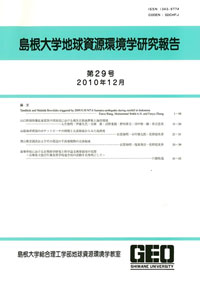島根大学総合理工学部地球資源環境学教室
ISSN:1343-9774

ダウンロード数 : ? 件
この文献の参照には次のURLをご利用ください : https://ir.lib.shimane-u.ac.jp/35672
島根大学地球資源環境学研究報告 34
2016-03-05 発行
Phengites in garnet-aegirine-augite schists from the Sambagawa metamorphic belt, Bizan district, eastern Shikoku, Japan
ファイル
内容記述(抄録等)
The Sambagawa metamorphic belt in the Bizan area consists mainly of pelitic schists, basic schists, and siliceous schists (garnet-aegirine-augite schists), along with minor garnet glaucophane schists. The garnet?aegirine-augite schists consist mainly of quartz and phengite, with minor amounts of amphibole (ferroglaucophane, magnesioriebeckite, riebeckite, Mg-katophorite, winchite, barroisite, ferrobarroisite), garnet, aegirine-augite and albite. Hematite, chlorite, epidote, calcite and titanite occur, occasionally phengites are found in eight modes of occurrence; phengites as inclusions in porphyroblastic garnet (Ph1), amphibole (Ph2), clinopyroxene (Ph3) and albite (Ph4), phengites (Ph5) occurring in the matrix, and phengites as a secondary mineral replacing porphyroblastic garnet (Ph6), amphibole (Ph7) and clinopyroxene (Ph8) along their rim and crack. The diversity of the modes of occurrence and chemical compositions of the phengites reflects two metamorphic events in the garnet-aegirine-augite schists in the Bizan area. Inclusions in garnet (Ph1), amphibole (Ph2) and clinopyroxene (Ph3) and schistosity-forming phengites (Ph5) are representative of the prograde to the peak metamorphism of the eclogitic metamorphic event. Phengites replacing garnet (Ph6), amphibole (Ph7) and clinopyroxene (Ph8) and phengites inclusions in porphyroblastic albites (Ph4) suggest another high-pressure epidote-amphibolite metamorphic event.
Other Article
PP. xxi - xxiv
PP. 89 - 93
